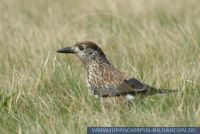Nucifraga caryocatactes
Eurasian nutcracker
Exif Keywords:
Exif ImageDescription: Nucifraga caryocatactes, Tannenhäher, Eurasian nutcracker
The Spotted Nutcracker, or just Nutcracker, (Nucifraga caryocatactes) is a passerine bird slightly larger than the Eurasian Jay. It has a much larger bill and a slimmer looking head without any crest. The feathering over its body is predominantly a chocolate brown with distinct white spots and streaks. The wings and upper tail are virtually black with a greenish-blue gloss. It is one of two species of nutcracker, the other, Clark's Nutcracker (Nucifraga columbiana), replacing it in western North America. The Spotted Nutcracker has an extensive range forming a broad swathe east-west from Scandinavia right across northern Europe, Siberia and to eastern Asia, including Japan, inhabiting the huge taiga conifer forests in the north. Three further disjunct populations occur in mountain conifer forests further south, one centered on the mountains of central and southeast Europe (the Alps, the Carpathians and the Balkan Peninsula mountains); another in the western Himalaya; and the third in western China seaboard and separated from the northern population by a relatively small gap in the north centre of China. Some of the populations can be separated on bill size. The most important food resources for this species are the seeds (pine nuts) of various Pines (Pinus sp.), principally the cold-climate (far northern and high altitude) species of white pine (Pinus subgenus Strobus) with large seeds: P. armandii, P. cembra, P. koraiensis, P. parviflora, P. peuce, P. pumila, P. sibirica and P. wallichiana, and also the two lacebark pines in subgenus Ducampopinus, P. bungeana and P. gerardiana. In some regions, where none of these pines occur, the seeds of Spruce (Picea sp.) and Hazel nuts (Corylus sp.) form an important part of the diet too. The forms that take Hazel nuts have thicker bills for cracking their hard shells, with a special ridge on the inside of the bill edge near the base. If the shell is too hard, it holds the nut between its feet and hacks at it with its bill like a chisel. Surplus seed is always stored for later use and it is this species that is responsible for the sowing of new trees of their favoured pines, including the re-establishment of the Swiss Pine (Pinus cembra) over large areas in the Alps of central Europe formerly cleared by man. Various insects are also taken, and also birds' eggs and nestlings, and it will take meat from animals caught in trappers' traps, including fish if that is used as bait. It digs out bumble bee and wasp nests avidly to get at the grubs. Nesting is always early in this species across its whole range, so as to make the best use of pine nuts stored the previous autumn. The nest is usually built high in a conifer (sometimes broadleaved trees are used) and usually on the sunny side. There are normally 2-4 eggs laid and incubated for 18 days. Both sexes feed the young which are usually fledged by about 23 days and stay with their parents for many months, following them to learn the food storage techniques essential for survival in their harsh environment. The voice is very like that of the Eurasian Jay and is loud and harsh. It is described as kraak-kraak-kraak-kraak. Spotted Nutcrackers are not migratory, but will erupt out of range when a cone crop failure leaves them short of a food supply, the thin-billed eastern race being the more likely to do this. Vagrants of this species to western Europe can be very confiding....Source:Wikipedia
Viewed 5616 times







